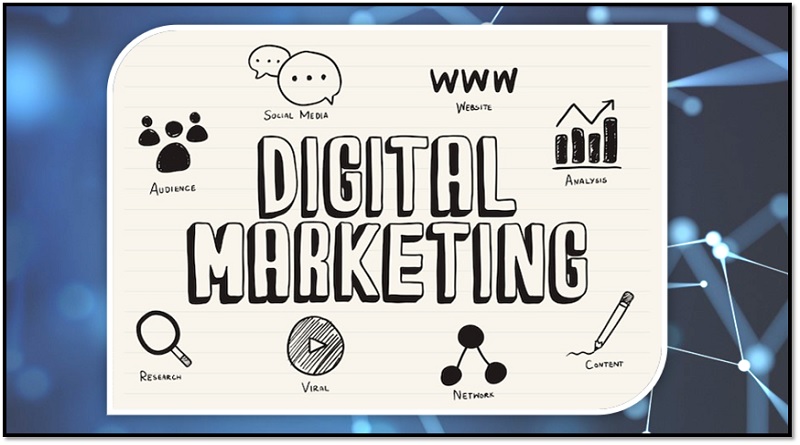Reinventing Web Design: Grapes Studio Lets Small Businesses Build Sites in Minutes
6 Key Components That Must Be Included In A Digital Marketing Strategy

Every effective marketing endeavor is built on a solid marketing strategy. A well-defined digital marketing strategy is either absent from more than half of the brands or has not yet been implemented. Because it provides you with a sense of direction, explains the goals you want to reach, and outlines the measures you must take to get there, a digital marketing strategy is crucial. You may create effective digital marketing campaigns for your organization that get the best outcomes at the lowest cost by fusing the appropriate digital business tactics. The key elements of a good digital marketing plan are described in this article.
Building A Digital Marketing Strategy:
Your marketing strategy gives a broad overview of the factors influencing the resources, actions, and goals. It must include the particular steps you’ll take to implement that strategy. By informing, entertaining, and persuading people, digital media offers various options to generate leads, convert consumers, and increase brand awareness. The plan enables a company to take advantage of the numerous online contact points that are potentially available. Since creating a digital marketing strategy can be complicated, contacting a marketing agency, such as Denver Digital Marketing Agency, or any other organization that operates locally in your region is advisable. However, if you wish to work independently, here are some steps to undertake when making a digital strategy.
- Create Buyer Persona: A buyer persona is a profile of the perfect client. Buyer personas contain vital demographic and psychological data that aid in identifying, understanding, and engaging with your target market.
- Identify Your Goals: The objectives of your marketing plan should align with those of your company, build brand recognition, and provide high-quality leads.
- Select The Right Tools: Ensure you have the appropriate tools to gauge your goals’ success once you’ve identified them. Online tools like social media schedulers provide analytics that can be used to monitor your audience’s preferences.
- Choose Appropriate Platforms: Collect your materials across all your media types and determine which platform would bring the highest results.
Key Components:
To effectively communicate your brand message, critical components of a customer-driven marketing plan should be streamlined. Most of the components of digital marketing function best in combination with some or all of the other components. Some of the common components that every marketing strategy must have are:
1. Responsive Web Design:
Your website is the cornerstone of any marketing campaign because it is the most likely first place potential buyers will go to learn more about your company. To optimize engagement, your website should adhere to best practices, such as being responsive, mobile-friendly, and simple to use with a clear call to action. Your website should also have a blog that regularly publishes interesting, relevant, and informative content. Not only will this increase website traffic and help turn those visitors into customers, but blogging can also help your brand establish itself as a thought leader in its field and boost search engine optimization (SEO). The blog content can even be repurposed across various other marketing channels.
2. SEO Strategy:
SEO, or search engine optimization, is the technique of optimizing your website with certain keywords so that both your site and its web pages rank higher in search results. A well-planned SEO strategy can boost the visibility of your website and raise the chance of a potential consumer interacting with your brand. Some SEO best practices are:
- Mobile-friendly website
- Incorporating relevant keywords after conducting keyword research.
- Having a range of backlinks.
- Improving voice searches.
- Enhancing the website user experience.
- Using local landing pages and listings to target local searches.
3. Social Media Marketing:
Social media can be a helpful tool for brands to boost interaction with followers and promote products and services. An effective social media strategy has several benefits, such as boosting website traffic, brand recognition, and company visibility. When creating your plan, make sure to take the best practices for social media into account. Choosing the appropriate social media channels for your target audience, posting during peak engagement hours, keeping a consistent posting schedule, and continually adjusting your strategy in reaction to outcomes over time are a few of these.
4. Advertising Campaigns:
There are four basic categories of digital advertising:
- Search/pay-per-click (PPC)
- Display
- Social media
- Retargeting ads
It is a significantly less expensive substitute for traditional advertising that tracks your audience in real time using consumer data to understand consumer demographics, interests, and behaviors. Digital advertising is a dynamic and measurable tool that any organization can utilize to increase brand recognition, produce high-quality leads, and promote product sales.
5. Content Marketing:
The purposeful use of written articles, infographics, videos, and other creative content to achieve organizational goals is known as content marketing. A content marketing specialist evaluates the target audience to identify which type of content will effectively deliver the desired message. Digital content marketers must develop proficiency in publishing and distribution in addition to producing blog posts, bite-sized videos, podcasts, and other assets. Although lead generation and customer conversion are key performance indicators (KPIs) that gauge the success of content marketing, content goals are generally centered around brand awareness.
6. Email Marketing:
You need to focus on email marketing if you want to expand your company. Email marketing helps with all facets of marketing, including lead generation, lead retention, and sales growth. Additionally, it is a quick and inexpensive method for interacting with clients and achieving business goals. An efficient method for generating leads and luring them to your goods and services is email marketing. The first step would be to concentrate on the buyer persona and deliver them a targeted message that is tailored and correctly designed for various devices to generate relevant traffic and leads.
Conclusion:
The basis of life cycle marketing is engagement between a brand and a customer at each stage of the relationship. It takes into account the practical and emotional variables affecting the buyer’s purchase decisions. Many firms use conventional market research techniques to collect these data. Customer persona development, market analysis, corporate positioning, and the gathering of other relevant data all require research.




